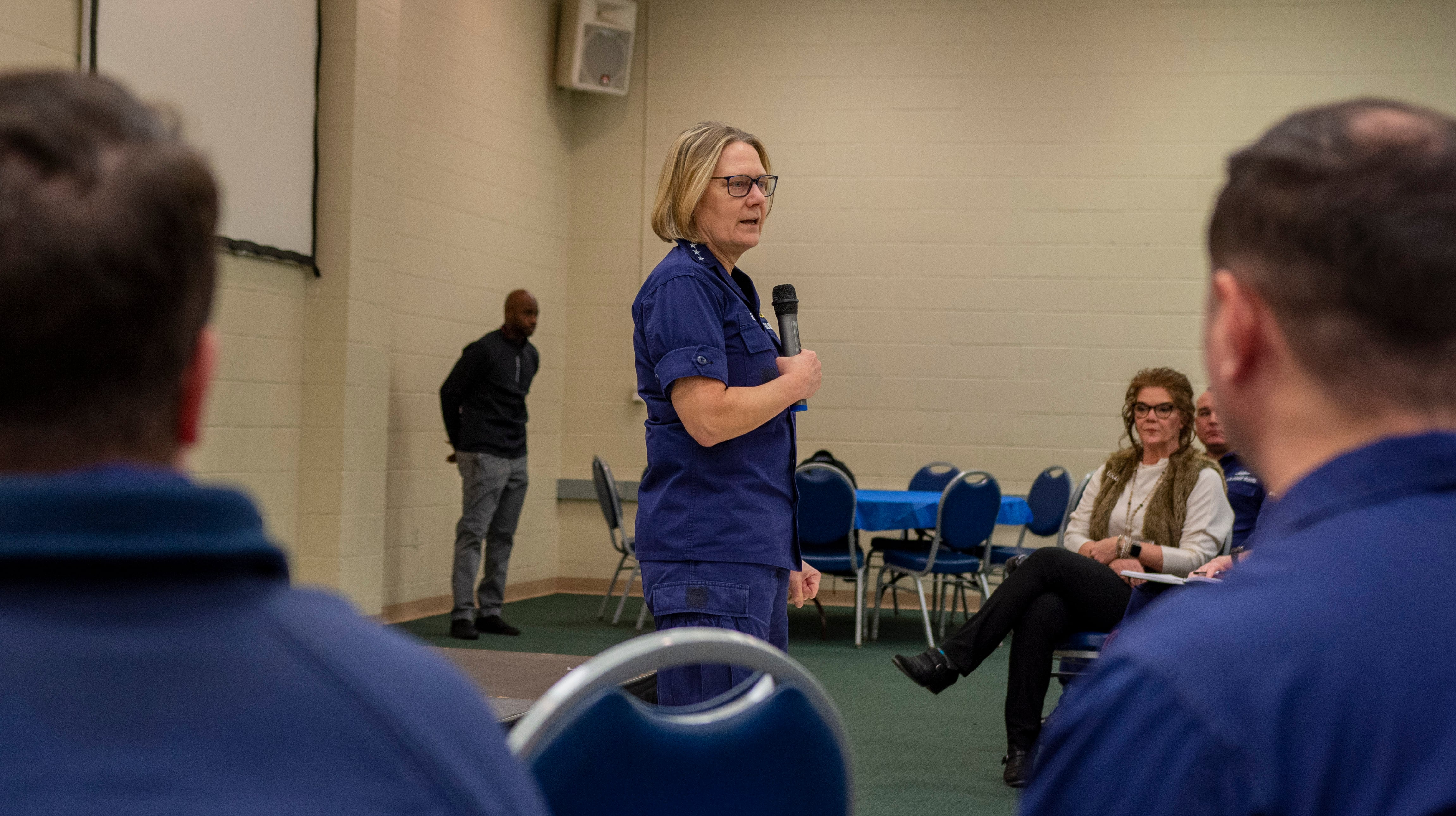FORT JACKSON, S.C. – After 527 hours of running, marching, shooting and studying, Staff Sgt. Jared Allen stood at attention as he received his coveted drill sergeant identification badge.
"When I was a kid, I needed direction, I needed a mentor, I needed an example of who I wanted to be," the infantryman said. "My drill sergeant was that for me, so in a way, I'd like to reciprocate that."
Allen, who has served four combat deployments, volunteered to be a drill sergeant after eight years in the Army.
On Aug. 27, he graduated from the Drill Sergeant Academy and donned the distinctive campaign hat, becoming one of the newest graduates of a 50-year-old program that prepares noncommissioned officers for duty "on the trail."
Known for its punishing hours, drill sergeant duty isn't for everyone. But for those who can make the cut, it offers gratification, special duty pay and extra consideration when you're up for that next promotion.
The Army has about 2,000 drill sergeants serving here at Fort Jackson, and also at Fort Benning, Georgia; Fort Leonard Wood, Missouri; Fort Sill, Oklahoma; and Lackland Air Force Base, Texas.
More than half of them are combat arms soldiers, while about 28 percent come from combat support and another 18 percent from combat service support MOSs.
The Drill Sergeant Academy at Fort Jackson trains all Army drill sergeants, producing 1,200 to 1,400 each year to meet the annual turnover rate across the force, according to Human Resources Command.
"It's a difficult task, it requires long hours," said Command Sgt. Maj. Dennis Woods, the senior enlisted soldier for the Army Center for Initial Military Training. "But if you can show you can handle people, you've identified yourself as talent. The Army is a people business. It takes leadership to move individuals from one event to the next."
Recent promotion numbers show that soldiers who serve as drill sergeants or advanced individual training platoon sergeants are 33 percent more likely to be promoted from staff sergeant to sergeant first class, Woods said.
"That number is based on a 13-series [field artillery] NCO," he said. "In an era when the Army is drawing down, somebody could be leveraging this experience to move forward."
An analysis of the recent E-7 promotion board results, across all military occupational specialties, show that NCOs with drill sergeant or AIT platoon sergeant experience had an increase over their peers who didn't serve in those jobs, according to HRC.
Infantry branch managers view drill sergeant duty as a career broadening assignment, said Sgt. Maj. Timothy Cantwell, the infantry branch sergeant major at HRC.
"That'll put them ahead of their peers because it shows they can work outside their MOS," he said.
A quick Google search of command sergeants major shows that about eight out of 10 previously served as drill sergeants, said Command Sgt. Maj. Lamont Christian, the commandant of the Drill Sergeant Academy.
"I haven't done any empirical data checks or anything like that, but just the photos alone, if you want to do a quick anecdotal check, that's pretty powerful," he said.
Being a drill sergeant "crosses all lines," he said. "It crosses MOS lines, it crosses gender lines, it crosses ethnicity lines."
The reason drill sergeants go on to have successful careers is the broad knowledge they gain on the trail, he said.
"That transformation from civilian to soldier requires you to be a master of formations," Christian said. "That's what they look for in your senior leader positions. How well do you manage time? How well do you manage training? How well do you manage talent? You become very good at that over a two-year period, so you understand soldiers' strengths and vulnerabilities."
Sgt. 1st Class Kimberly Edwards, the branch manager for drill sergeants and AIT platoon sergeants, agreed.
"You're teaching civilians to become soldiers," she said. "Not everybody is actually qualified to do that."
Drill sergeants also receive a little extra cash for their hard work — a monthly stipend worth $375.
But many of those who've served as drill sergeants say the gratification of forging young soldiers is the greatest payoff.
Christian, who was on the trail from 1994 to 1998 at Fort Benning, said he was inspired by his drill sergeant, Staff Sgt. Anderson.
"He's the reason I left reserve status to become an active-duty soldier and pursue being a drill sergeant," Christian said. "That's all I wanted to do. I wanted to give back."
Staff Sgt. Juliana Morrison was a drill sergeant from October 2011 to March 2013 before she became a drill sergeant leader at the schoolhouse.
Being on the trail requires sacrifice, mainly of your personal life, she said.
"But you're investing and committing to the future of the Army you're going to be in," she said. "I think it's a very important job to have. You have to develop that future soldier, and it's really gratifying. One way or another, you're making a difference in somebody's life."
At the schoolhouse, Morrison said she sees the transformation in NCOs who maybe at first didn't want to be tapped for drill sergeant duty.
"It's funny, some of these guys don't want to do this job," she said. "They'll talk s---, but when you see them out there with their hat on, they're totally invested."
Job requirements
Drill sergeant duty is for two years, and NCOs have the option to extend for a third year.
Soldiers who want to volunteer to serve on the trail can call their career manager or use the Assignment Satisfaction Key, an online HRC program that allows soldiers to view and update assignment preferences and personal information.
Information in the ASK is used by assignment managers and professional development NCOs to match a soldier's preferences against Army requirements.
To qualify to be a drill sergeant, soldiers must have a General Technical score of 100, or they can apply for a waiver down to a score of 90, said Sgt. 1st Class Ronald Russell, the professional development NCO at HRC for infantry staff sergeants.
About 26 percent of all drill sergeants come from the infantry.
Candidates must have completed the Warrior Leader Course, and infantry NCOs must have 18 to 24 months of rated squad leader or section leader time, Russell said.
In addition, soldiers must be able to pass a background check, and those who are on profile can only have restrictions for hearing or vision, he said.
"We look for soldiers that stand out from the rest," Russell said. "The top 10 percent, for soldiers who can lead and train."
On top of those requirements, drill sergeant candidates should have confidence and presence, said Sgt. Maj. Edward Roderiques, the deputy commandant of the Drill Sergeant Academy.
"That's not to say those attributes must be fully developed when we receive them," he said. "Those are things we can help instill."
After struggling for a few years, the operational Army now recognizes the need to provide quality NCOs for drill sergeant duty, Christian said.
"In the past, we were challenged because we were an Army at war," he said. "The opportunity to fulfill drill sergeant assignments was not necessarily a priority, and we didn't ensure the candidates sent here were the best prepared."
When NCOs arrive at the Drill Sergeant Academy, they are put through a near nine-week course.
In the past, these drill sergeant candidates were run through training as if they were privates again.
Today, the model has shifted. Drill sergeant candidates are put through the training, but they're also taught to mentor. There also is a heavy emphasis on academics, with lessons on subjects such as leadership, resilience, and counseling techniques.
About 75 drill sergeant leaders — active-duty and Army Reserve — serve at the schoolhouse, Christian said.
Drill sergeants' drill sergeants
Drill sergeant leaders are drill sergeants who've served at least a year on the trail.
There's a "drastic difference" when it comes to training NCOs compared with training privates, Morrison said.
"With NCOs, it's so much harder to break habits than to make them," she said.
For Sgt. 1st Class Travis Knudsen, his experience as a drill sergeant and then as a drill sergeant leader has made him a better NCO.
"I learned more in that first year as a drill sergeant than I did the nine years prior to that," he said. "It was a huge amount of experience in a short period of time."
Knudsen, an infantryman, served on the trail at Fort Benning from August 2011 to August 2012 before moving to the schoolhouse. This spring, he'll move on to his next assignment with the 173rd Airborne Brigade Combat Team in Vicenza, Italy.
"I knew doing this job would make me an expert at training soldiers, and in my opinion, an NCO's job, first and foremost, is training soldiers," he said.
Being a drill sergeant is time-consuming and difficult, Knudsen said.
"It's a six-day work week," he said, adding that he often got to work at 4:30 a.m., about 30 minutes before the privates' wake-up time at 5 a.m.
"Then you're with the soldiers until lights out at 2100," he said. "One of the things I found out early on is the success of your soldiers comes at the sacrifice of your time."
But "one of the coolest things" was seeing the change and growth in those young soldiers and knowing you were responsible for it, Knudsen said.
"Today, every soldier has to be a thinker," he said. "The importance of having good and solid drill sergeants is the soldiers will do whatever you tell them to do, so you have to have the right leaders who will teach them the right thing."
Michelle Tan is the editor of Army Times and Air Force Times. She has covered the military for Military Times since 2005, and has embedded with U.S. troops in Iraq, Afghanistan, Kuwait, Haiti, Gabon and the Horn of Africa.





